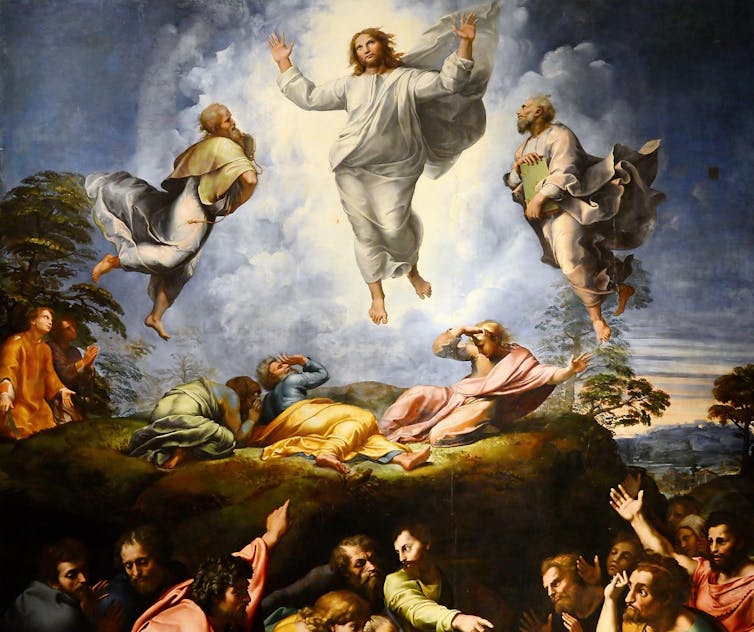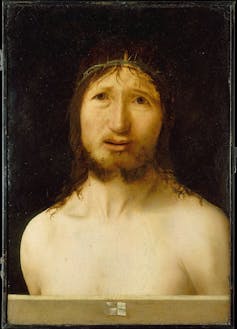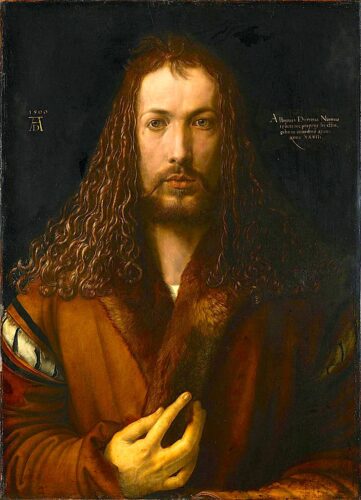White, European representations of Christ are under renewed scrutiny during this period of introspection over the legacy of racism in society, writes Anna Swartwood House.

By Anna Swartwood House
University of South Carolina
 The portrayal of Jesus as a white, European man has come under renewed scrutiny during this period of introspection over the legacy of racism in society.
The portrayal of Jesus as a white, European man has come under renewed scrutiny during this period of introspection over the legacy of racism in society.
As protesters called for the removal of Confederate statues in the U.S., activist Shaun King went further, suggesting that murals and artwork depicting “white Jesus” should “come down.”
His concerns about the depiction of Christ and how it is used to uphold notions of white supremacy are not isolated. Prominent scholars and the archbishop of Canterbury have called to reconsider Jesus’ portrayal as a white man.
As a European Renaissance art historian, I study the evolving image of Jesus Christ from A.D. 1350 to 1600. Some of the best-known depictions of Christ, from Leonardo da Vinci’s “Last Supper” to Michelangelo’s “Last Judgment” in the Sistine Chapel, were produced during this period.
But the all-time most-reproduced image of Jesus comes from another period. It is Warner Sallman’s light-eyed, light-haired “Head of Christ” from 1940. Sallman, a former commercial artist who created art for advertising campaigns, successfully marketed this picture worldwide.
Through Sallman’s partnerships with two Christian publishing companies, one Protestant and one Catholic, the Head of Christ came to be included on everything from prayer cards to stained glass, faux oil paintings, calendars, hymnals and night lights.
Sallman’s painting culminates a long tradition of white Europeans creating and disseminating pictures of Christ made in their own image.
In Search of the Holy Face
The historical Jesus likely had the brown eyes and skin of other first-century Jews from Galilee, a region in biblical Israel. But no one knows exactly what Jesus looked like. There are no known images of Jesus from his lifetime, and while the Old Testament Kings Saul and David are explicitly called tall and handsome in the Bible, there is little indication of Jesus’ appearance in the Old or New Testaments.
Even these texts are contradictory: The Old Testament prophet Isaiah reads that the coming savior “had no beauty or majesty,” while the Book of Psalms claims he was “fairer than the children of men,” the word “fair” referring to physical beauty.
The earliest images of Jesus Christ emerged in the first through third centuries A.D., amidst concerns about idolatry. They were less about capturing the actual appearance of Christ than about clarifying his role as a ruler or as a savior.
To clearly indicate these roles, early Christian artists often relied on syncretism, meaning they combined visual formats from other cultures.
Probably the most popular syncretic image is Christ as the Good Shepherd, a beardless, youthful figure based on pagan representations of Orpheus, Hermes and Apollo.
In other common depictions, Christ wears the toga or other attributes of the emperor. The theologian Richard Viladesau argues that the mature bearded Christ, with long hair in the “Syrian” style, combines characteristics of the Greek god Zeus and the Old Testament figure Samson, among others.
Christ as Self-Portraitist
The first portraits of Christ, in the sense of authoritative likenesses, were believed to be self-portraits: the miraculous “image not made by human hands,” or acheiropoietos.

(Tretiakov Gallery, Moscow)
This belief originated in the seventh century A.D., based on a legend that Christ healed King Abgar of Edessa in modern-day Urfa, Turkey, through a miraculous image of his face, now known as the Mandylion.
A similar legend adopted by Western Christianity between the 11th and 14th centuries recounts how, before his death by crucifixion, Christ left an impression of his face on the veil of Saint Veronica, an image known as the volto santo, or “Holy Face.”
From the perspective of art history, these artifacts reinforced an already standardized image of a bearded Christ with shoulder-length, dark hair. These two images, along with other similar relics, have formed the basis of iconic traditions about the “true image” of Christ.
In the Renaissance, European artists began to combine the icon and the portrait, making Christ in their own likeness. This happened for a variety of reasons, from identifying with the human suffering of Christ to commenting on one’s own creative power.
The 15th-century Sicilian painter Antonello da Messina, for example, painted small pictures of the suffering Christ (above) formatted exactly like his portraits of regular people, with the subject positioned between a fictive parapet and a plain black background and signed “Antonello da Messina painted me.”
 The 16th-century German artist Albrecht Dürer blurred the line between the holy face and his own image in a famous self-portrait of 1500 (left). In this, he posed frontally like an icon, with his beard and luxuriant shoulder-length hair recalling Christ’s. The “AD” monogram could stand equally for “Albrecht Dürer” or “Anno Domini” – “in the year of our Lord.”
The 16th-century German artist Albrecht Dürer blurred the line between the holy face and his own image in a famous self-portrait of 1500 (left). In this, he posed frontally like an icon, with his beard and luxuriant shoulder-length hair recalling Christ’s. The “AD” monogram could stand equally for “Albrecht Dürer” or “Anno Domini” – “in the year of our Lord.”
In Whose Image?
This phenomenon was not restricted to Europe: There are 16th- and 17th-century pictures of Jesus with, for example, Ethiopian and Indian features.
In Europe, however, the image of a light-skinned European Christ began to influence other parts of the world through European trade and colonization.
The Italian painter Andrea Mantegna’s “Adoration of the Magi” from A.D. 1505 features three distinct magi, who, according to one contemporary tradition, came from Africa, the Middle East and Asia. They present expensive objects of porcelain, agate and brass that would have been prized imports from China and the Persian and Ottoman empires.
But Jesus’ light skin and blues eyes suggest that he is not Middle Eastern but European-born. And the faux-Hebrew script embroidered on Mary’s cuffs and hemline belie a complicated relationship to the Judaism of the Holy Family.
In Mantegna’s Italy, anti-Semitic myths were already prevalent among the majority Christian population, with Jewish people often segregated to their own quarters of major cities.
Artists tried to distance Jesus and his parents from their Jewishness. Even seemingly small attributes like pierced ears – earrings were associated with Jewish women, their removal with a conversion to Christianity – could represent a transition toward the Christianity represented by Jesus.
Much later, anti-Semitic forces in Europe including the Nazis would attempt to divorce Jesus totally from his Judaism in favor of an Aryan stereotype.
White Jesus Abroad
As Europeans colonized increasingly farther-flung lands, they brought a European Jesus with them. Jesuit missionaries established painting schools that taught new converts Christian art in a European mode.
A small altarpiece made in the school of Giovanni Niccolò, the Italian Jesuit who founded the “Seminary of Painters” in Kumamoto, Japan, around 1590, combines a traditional Japanese gilt and mother-of-pearl shrine with a painting of a distinctly white, European Madonna and Child.

(Museo Nacional de Arte)
In colonial Latin America – called “New Spain” by European colonists – images of a white Jesus reinforced a caste system where white, Christian Europeans occupied the top tier, while those with darker skin from perceived intermixing with native populations ranked considerably lower.
Artist Nicolas Correa’s 1695 painting of Saint Rose of Lima, the first Catholic saint born in “New Spain,” shows her metaphorical marriage to a blond, light-skinned Christ.
Legacies of Likeness
Scholar Edward J. Blum and Paul Harvey argue that in the centuries after European colonization of the Americas, the image of a white Christ associated him with the logic of empire and could be used to justify the oppression of Native and African Americans.
In a multiracial but unequal America, there was a disproportionate representation of a white Jesus in the media. It wasn’t only Warner Sallman’s Head of Christ that was depicted widely; a large proportion of actors who have played Jesus on television and film have been white with blue eyes.
Pictures of Jesus historically have served many purposes, from symbolically presenting his power to depicting his actual likeness. But representation matters, and viewers need to understand the complicated history of the images of Christ they consume.![]()
Anna Swartwood House is assistant professor of art history at the University of South Carolina.
This article is republished from The Conversation under a Creative Commons license. Read the original article.
Please Contribute to Consortium
News on its 25th Anniversary
Donate securely with  PayPal here.
PayPal here.
Or securely by credit card or check by clicking the red button:




The idea that someone, anyone, characterising Christ as a member or their race is rascist is ridiculous.
In the late 1980s and early 1990s, I recall seeing statues of Jesus outside churches in Solomon Islands and Papua New Guinea with very dark skin and Melanesian facial features.
Call that “racism” if you wish; I do not.
Church fathers in the early fourth century appropriated the image of the blue-eyed, fair-haired Macedonian King Alexander the Great to represent their Savior. No portrait existed of Jesus, because of the Judaic convention forbidding artistic representations of living beings. Alexander’s image was ubiquitous in the Graeco-Roman world, an instantly recognizable cultural icon of a man universally revered, whom many claimed was the son of Zeus himself. Church officials reasoned that the familiar portrait of the man who conquered the world 650 years earlier would be the ideal model for the likeness of the man they believed conquered death. As a visual aid to encourage conversion, it would serve as an excellent recruiting tool for the illiterate masses the church sought to bring under its dominion.
Around the same time, in the 320s CE, some coins of the emperor Constantine depicted him in the aspect of Alexander called “the melting gaze”, with his eyes tilted heavenward as though in prayer. Some modern historians think this unusual stare with the head tilted unnaturally backward is symptomatic of what is now called Brown’s syndrome. It is likely the result of a sword wound to the face that Alexander is known to have received, but was imitated by Constantine’s die engravers to identify their leader with both Alexander and Jesus.
Similarly, depictions of Jesus carrying a lamb on his shoulders are copies of classical Greek statues of Apollo (another holy son) in his aspect of the Good Shepherd. The Madonna and Child are likewise modeled on art works depicting the Egyptian goddess Isis suckling her infant son Horus, another iconic sacred image beloved in the ancient world long before Christianity.
It is quite possible that ancient Jews were the same color as modern Jews. The burden of proof is on people claiming that Jews have changed color in 2000 years. Apart from Sammy Davis Jr. and a small minority, today’s Jews have the same range of skin color as modern Europeans with lighter skin in northern Europe and darker skin in southern Europe .Until recently. they have been very strict about only marrying other Jews so it is hard to see how they would change color. Artists during the middle ages could have gone by the skin color of the Jews of their time. Are there any ancient Roman sources saying that Jews were a different color from Romans?
I’m agnostic, but as someone who was raised Jewish, I’ve never figured out how idolatry suddenly became ok in a religion that kept the old testament.
I don’t think Christianity really “kept” the Old Testament. I reckon good old Jesus wanted to give them all something new and fresh, but wanted to keep things just a bit cool with the Rabbis and powers that be. And show a bit of respect for his elders – never hurts.
Showing respect for your elders absolutely can cause massive harm. Especially if you were raised by narcissists (a term which is often a euphemism in this particular use).
Should note that I have no intention of bagging on Jesus himself here. As far as the inclusion of the old testament goes, I strongly disagree, and I don’t think he intended to end up being idolized the way he is. Maybe I’m wrong, but regardless, what I’m taking aim at is how there are statues of him in most churches, how there’s that giant statue down in Brazil, and so on. That’s the bonafide idolatry.
I don’t know… Wouldn’t you just ask him? And if he answered you then what?
Since he was apparently born in the Middle East and sojourned to North East Africa to hide and therefore blend with the people who were living there at that point in time who were Kemets.
He was definitely not an European or having European features.
When you visit Rome and you enter the cathedrals.
They have a true representation of what he looks like. A very dark skinned image.
Historical Jesus? Any source outside of the New Testament? A matter-of-fact, casually written statement of historical existence, despite the lack of evidence, detracts from what could have been a more interesting essay on the actual history of the religious and racial aspects of European colonialism.
For Christians Christ consciousness means the achievement of spiritual awakening & enlightenment. So whatever image assists in getting you to that place is the “real” Christ. He can be visualized as any color, wearing any historical clothing or in any geographical location. I imagine that medieval artists painted him as white because their patrons & parishioners were European. But – other places, other images. Whatever focuses your attention on eternity.
‘God’ did not create us in his image, we created him in ours.
If the man existed, and I highly doubt this, he was a product of the Mediterranean. Meaning olive-skinned.
Travel to some of the churches of the world, and depending on where you go, the depictions of so-called Christ are dissimilar. In Latin America, he is depicted as darker skinned. In Europe, he is fair, blue of eye and blonde. Ditto with North America.
Religion is the bane of civilization. It is divisive, It retards the acquisition and use of natural law. In the 21st century, we are *still* fighting wars over religion. People die because they do not believe in the proper god.
The sooner we consign this superstition to the trash bin, the better.
Maybe El Greco’s interpretation is the most historically accurate? en.wikipedia.org/wiki/Christ_Carrying_the_Cross_(El_Greco,_New_York)
When has mankind within the three major and most powerful reliviondnot depicted their common godhead as having human attributes and in their own image?
Long have we not been rule d by “self made men” that worship their creator.
Neither Islam nor Judaism have portrayed their God in human form.
Um, lets see if I got this right. You are perfectly willing to go along with the idea that this guy was born of a virgin, that he walked on the water, that he manifested enough bread and fish out of thin air to feed a multitude, that he died from getting nailed to a wooden cross, was sealed away in a cave but came back to life and floated up into the sky but when it comes to the color of his skin, you’re like, “Oh, no. It couldn’t possibly have white because he was born in the Middle East.”
Seriously. . . ?????
I fully concur with the foregoing objections this scholarly work. My objection to the objections is simply that nowhere do they set out to prove the existence of Jesus, nor describe him as a living historical figure. The book sets out to study and report on the various physical manifestations of the religious figure known as Jesus throughout history. I think it would be better to comment on the success or failure of their research, rather than measures it by a yardstick they never acknowledged.
Nicely put, giggle. But as I understand it, there is evidence that there was a person around which the myth of Jesus’ divinity developed – like King Arthur and his knights.
Pretty good! Thanks from a Roman historian!
An interesting piece, for sure.
However, it should not be forgotten that people have a natural tendency to try identifying their beliefs with their own circumstances.
It is not insidious or prejudiced. It is just what people do.
There are many interpretations of the face of Jesus in Africa as Black for example.
Jesus being black would be more representative than him being white. That’s the point. The dominate image of Christ is that of a white European male, which couldn’t be further from the truth.
There are depictions of him as a Chinese/Asian man in China too.